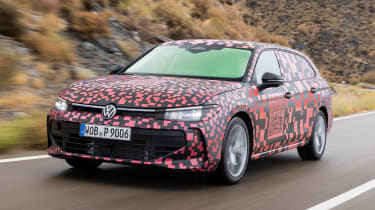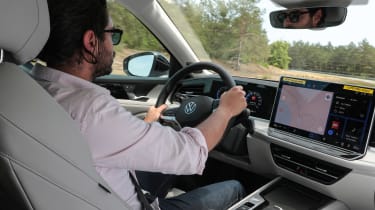New Volkswagen Passat prototype review
The next generation Volkswagen Passat has already impressed us ahead of its official debut
Volkswagen is on the cusp of revealing its next generation Passat, a staple nameplate for the VW brand that’s now in its ninth iteration. Yet even a model as established as the Passat isn’t immune to change, so while it will retain many of the elements that have defined the large and practical family car over the best part of 50 years, there are some substantial modifications in store. For now, we’ve been given the chance to have an early drive of a late-stage prototype to see if it still appeals to the metrics that made its predecessors so successful.
The first of these major changes is that the Passat will now only be available as an estate, with the traditional three-box saloon being indirectly replaced by the all-electric ID.7. Yet even considering its estate-only status, the new scale of the Passat is immediately apparent, growing in length by a substantial 144mm. Fifty millimetres of that is found in the wheelbase to the benefit of rear legroom, and the boot’s now bigger to the tune of 40 litres, adding up to 690 litres. With the rear seats folded, this grows by 140 litres to 1920 litres.
While the body is all-new, under the skin it will ride on a heavily updated MQB-evo platform that will also underpin the new Tiguan, as well as the next generation Skoda Kodiaq and Superb. While the platform hasn’t been entirely reformed, its changes have been focused around better integrating VW’s next generation electronics and plug-in hybrid powertrains.
More reviews
Car group tests
In-depth reviews
Road tests
Powering the new Passat will be a combination of petrol, diesel and plug-in hybrid models, with the UK still to confirm specific options. The most heavily upgraded powertrain options are the plug-ins, which come in 200bhp and 268bhp forms that both pair a 1.4-litre turbocharged petrol engine with an electric motor and battery pack. A larger battery pack is projected to offer anywhere between 55 and 75 miles of all-electric range, and increased charging speeds too. This, as well as the substantially reduced CO2 emissions, will reduce costs for company car buyers. No full EV model will be offered.
The model we’re driving now, though, makes do with a more traditional mild-hybrid turbocharged 1.5-litre petrol with around 148bhp, fitted with a dual-clutch DSG gearbox powering the front wheels. In contrast to looking relatively familiar on the outside, the Passat appears to have leaped a couple of generations inside, with a massive new 15-inch touchscreen interface dominating the cabin, joined by a secondary driver’s display and a new column mounted gear selector. While this does give the new Passat’s interior a streamlined look, the interior design has been designed to the discretion of VW’s customers, with feedback highlighting that the total lack of switchgear in its recent models like the Golf 8 and ID.3 didn’t sit well. As such, you’ll notice a return to physical buttons on the steering wheel, while the new user interface features static keys for the air conditioning controls.
On the road, a highlight of the new Passat is how refined and calm the driving experience is, even on tough road surfaces in and around VW’s Ehra Lessien testing facility. Over the sharpest of ridges, the suspension has impressive bump isolation and compliance, something made possible by the new, optional, dual-valve adaptive dampers that will also feature in the new Tiguan. The powertrain also feels impressively hushed, and while response times from the DSG and turbocharger combo can be a little slow to react, there’s certainly a tangible improvement over VW’s current models.
Pick up the pace, select the ‘Sport’ drive mode and the Passat handles with impressive composure and stability. Despite the extra length, it feels more agile than the current Passat thanks largely to its more sophisticated suspension and a slightly faster steering ratio.
But at its core, you can tell that VW has shrewdly positioned the new Passat to appeal to exactly the deliverables its customers want and need. While an estate version of the ID.7 is imminent for those ready to make the switch to EVs, for the sort of European customers that aren’t, the new Passat will not feel like a compromise.





